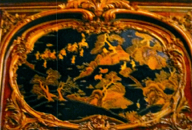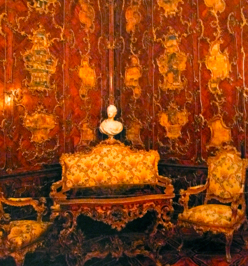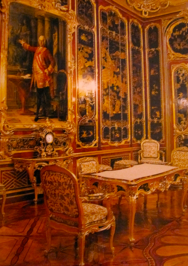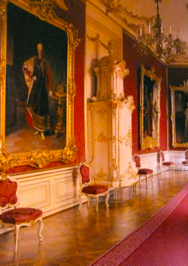schönbrunn Palace
Vienna, Austria
europe
december 10, 2010


schönbrunn Palace
Vienna, Austria
europe
december 10, 2010



Schönbrunn Palace is considered to be one of the most important cultural monuments in Austria. The former imperial summer residence in Vienna, the palace has remarkable architecture and furnishings. Rich woods, marble floors, vaulted ceilings, paneled rooms, exquisite silks, gilded furniture, inlaid stone, crystal chandeliers, beautiful sculpture, paintings and ceiling frescoes unite to make Schönbrunn palace one of the most beautiful palaces of all. On a snowy day in Vienna, Henry and I made the 9-stop subway trip from the center of Vienna on the U-4 to Schönbrunn Palace. This was our second occasion to visit the palace, the first time we toured it was in the Autumn of 1997; and, on this visit, the snow provided a totally new experience. Gone were the extraordinary gardens with tall hedges, fountains and pools, all closed during the winter and hidden beneath the white cover of snow. Still prominent and ready to view, was the glorious imperial summer palace that stood beneath a blanket of snow, shadowy amidst thick white flurries that veiled the edifice and its Christmas decorations. Henry and I chose the Grand Tour that allowed us to view the Imperial Apartments, the same tour we had made years before. I was interested in revisiting the Old Lacquer Room, an exquisite room that Maria Theresa had commissioned upon the death of her husband, Franz Stephan I. The palace was as grand and sumptuous as I remembered. Beginning in the 16th century, Schönbrunn was the site of a hunting lodge and summer residence of the Habsburg family. After the 16th century buildings were totally destroyed during the Turkish attack in 1685, Holy Roman Emperor Leopold I (in competition with Louis XIV of France) commissioned Johann Bernhard Fischer von Erlach to design and construct a palace that would outshine Versailles. Because of the costly wars, a more simple design than the one proposed by the architect was constructed, beginning in 1695, only partially completed at the death of the emperor in 1705. From the 18th century until the collapse of the Habsburg dynasty in 1918, Schönbrunn Palace was the residence of the Habsburg emperors. Leopold’s successor, Joseph I, used the finished a portion of the palace, but did little to add to the architectural complex. However, n the mid-18th century, Maria Theresa commissioned the architect Nicolaus Pacassi with the completion of the palace. The result is a palace filled with outstanding examples of decorative art and a remarkable example of Baroque architecture. The palace and the gardens, the site of the world’s first zoo, illustrate the tastes, interests, and aspirations of the successive Habsburg monarchs. When viewed together as a whole, the complex becomes a perfect example of Gesamtkunstwerk or a “complete work of art”. Notes on some of the rooms:
•The architect, Nicolaus Picassi presered Fischer von Erlach’s overall structure, yet the main part of the palace is largley Pacassi’s work. Access to the Piano Nobile is from the courtyard, up a monumental staircase leading to the Great Gallery, ornately decorated with stucco ornamentation and ceiling frescoes symbolizing the Habsburg Empire.
•Behind the Great Gallery lies the Small Gallery, flanked by two small rooms:
•The Chinese Round Room and the Chinese Oval Room, both decorated with black and gold painted lacquer panels and furnished with Japanese ceramics an furniture.
•The Vieux-Laque Room, is one of the most impressive and sumptuous rooms in the East Wing of the palace. The priceless oriental lacquer panels, set in walnut paneling and surrounded by gilded plasterwork and extremely ornate furniture was the commission by Maria Theresa after the death of her husband, the black lacquer and her black attire from that moment on were her expression of eternal love and grief.
•The Porcelain Chamber is a small room with ornately carved wainscoting, painted blue and white, decorated with 213 sketches by Franz Stephan an his children.
•The West Wing houses the the former apartment of Franz Joseph and his parents, and the Queen consort, “Sissy”. These rooms have been adapted to the 19th century style of furniture,adding historical importance to the palace.
Following the collapse of the monarchy in 1918, the newly formed Austrian Republic became the owner of Schönbrunn Palace, preserved as a museum. During the Allied Occupation of Austria after WW II (1945-55) Schönbrunn Palace, empty at the time, was requisitioned as office space by the British for their delegation to the Allied Commission and as Headquarters for the British Military Garrison present in Vienna. The palace was also used for other important events, including the meeting between John F. Kennedy, President of the United States of America (1960-63) and Nikita Khruschev, Premier of the Soviet Union (1953-64). In 1996, UNESCO placed Schönbrunn Palace and its gardens on the World Heritage List as a remarkable Baroque ensemble and example of synthesis of the arts.
PHOTOS: Left Column: 1. Schönbrunn Palace in the snow. 2. Reiches Zimmer or Room of Riches, Mary Theresa’s bedroom. Tapestry panels woven in silver and gold, bordered in red velvet and architectural details decorate the walls, the bed and canopy of this room. 3. Roten Salon or Red Salon has portraits of the emperors, each wearing the red velvet robes of the Holy Roman Empire. 4. Detail: Black lacquer panels from Peking, China, framed in gold. These decorate Maria Theresa’s sitting room as a symbol of mourning after the death of her husband, Franz I. 5. Black Pietra Dura design from Italy, a detail on one of the chests in the Blue Chinese Salon. Center, Top: Kleine Galerie or Small Gallery. Center, Middle: The Miniature Cabinet. Center, Bottom: Millionenzimmer, a grand salon. The paneled walls are fitted with rococo plaques framing collages made from Persian miniatures, fashioned by members of the royal family. Right Column: 1. Große Galerie or Large Gallery. 2. Chinesisches Kabinett or Chinese Cabinet, a room paneled in white with black rococo insets of Chinese lacquered panels. 3. Vieux-lacque Zimmer or Old Lacquer Room c. 1765. After her husband, Franz Stephan I, died, Marie Theresa had the room redecorated in black lacquered panels manufactured in Peking, each framed in gold and inset into walnut. Furthermore, she wore only black from that day onward.


Schloss Schönbrunn








